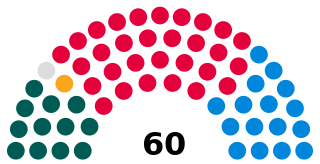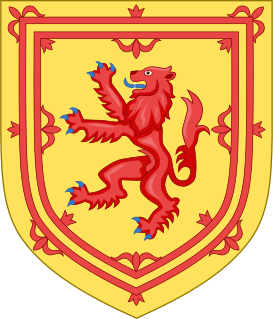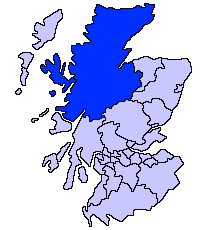Related Research Articles
Proportional representation (PR) characterizes electoral systems in which divisions in an electorate are reflected proportionately in the elected body. The concept applies mainly to geographical and political divisions of the electorate.
The politics of Edinburgh are expressed in the deliberations and decisions of the City of Edinburgh Council, in elections to the council, the Scottish Parliament and the UK Parliament.

The additional member system (AMS) is a mixed electoral system under which a part of the chamber of representatives are elected in single-member districts, and "additional members" are elected in such a way as to make the chamber more proportional to the way votes are cast for parties. It is another term to mean mixed-member proportional representation (MMP), But as the term additional member system is used here, AMS, unlike some MMP systems, does not compensate for the disproportionate results caused by a leading party taking so many district seats that the top-up seats cannot compensate. Such is the case where the leading party takes overhang seats and the legislature has a fixed number of seats. In some MMP systems, leveling seats are filled in such a way as to ensure parties have proportional representation.
Mixed-member proportional representation is a mixed electoral system in which voters get two votes: one to decide the representative for their single-seat constituency, and one for a political party. Seats in the legislature are filled first by the successful constituency candidates, and second, by party candidates based on the percentage of nationwide or region-wide votes that each party received. The constituency representatives are elected using first-past-the-post voting (FPTP) or another plurality/majoritarian system. The nationwide or region-wide party representatives are, in most jurisdictions, drawn from published party lists, similar to party-list proportional representation. To gain a nationwide representative, parties may be required to achieve a minimum number of constituency candidates, a minimum percentage of the nationwide party vote, or both.

The Senedd, officially known as the Welsh Parliament in English and Senedd Cymru in Welsh, is the devolved, unicameral legislature of Wales. A democratically elected body, it makes laws for Wales, agrees certain taxes and scrutinises the Welsh Government. It is a bilingual institution, with both Welsh and English being the official languages of its business. From its creation in May 1999 until May 2020, the Senedd was known as the National Assembly for Wales.
The boundary commissions in the United Kingdom are non-departmental public bodies responsible for determining the boundaries of constituencies for elections to the House of Commons. There are four boundary commissions:
Parallel voting describes a mixed electoral system where voters participate in an election, or in effect two elections that are organizationally combined, whereby representatives are voted into a single chamber using two or more different systems. Parallel voting, sometimes known as superposition,mixed member majoritarian (MMM) or the supplementary member (SM) system, usually combines first-past-the-post voting (FPTP) with party-list proportional representation (PR).
The alternative vote plus (AV+), or alternative vote top-up, is a semi-proportional voting system. AV+ was devised by the 1998 Jenkins Commission which first proposed the idea as a system that could be used for elections to the Parliament of the United Kingdom.

There are 39 multi-member electoral districts, known as Dáil constituencies, that elect 160 TDs, to Dáil Éireann, Ireland's lower house of the Oireachtas, or parliament, by means of the single transferable vote, to a maximum term of five years.

The Scottish Parliament (Holyrood), created by the Scotland Act 1998, has used a system of constituencies and electoral regions since the first general election in 1999.

In the United Kingdom (UK), each of the electoral areas or divisions called constituencies elects one member to the House of Commons.

As a result of the Fifth Periodical Review of the Boundary Commission for Scotland, Scotland is covered by 59 constituencies of the House of Commons of the United Kingdom Parliament - 19 Burgh constituencies and 40 County constituencies. Constituencies marked * appear on the Central Area Enlargement.
Historically, the single transferable vote (STV) electoral system has seen a series of relatively modest periods of usage and disusage throughout the world; however, today it is seeing increasing popularity and proposed implementation as a method of electoral reform. STV has been used in many different local, regional and national electoral systems, as well as in various other types of bodies, around the world.

Scottish Westminster constituencies were Scottish constituencies of the House of Commons of the Parliament of Great Britain, normally at the Palace of Westminster, from 1708 to 1801, and have been constituencies of the House of Commons of the Parliament of the United Kingdom, also at Westminster, since 1801. Constituency boundaries have changed on various occasions, and are now subject to both periodical and ad hoc reviews of the Boundary Commission for Scotland.

The third set of Highland Council wards, 22 in number, became effective for election purposes in 2007, for the fourth general election of the Highland Council. The new wards were created under the Local Governance (Scotland) Act 2004, and are as defined in recommendations of the Local Government Boundary Commission for Scotland.
The Politics of Aberdeen, Scotland have changed significantly in recent years. In 1996, under the Local Government etc. (Scotland) Act 1994, Grampian Regional Council and Aberdeen District Council were dissolved, creating the new unitary Aberdeen City Council to represent the city's council area.
Electoral reform is change in electoral systems to improve how public desires are expressed in election results. That can include reforms of:

There are five types of elections in the United Kingdom: elections to the House of Commons of the United Kingdom, elections to devolved parliaments and assemblies, local elections, mayoral elections and Police and Crime Commissioner elections. Within each of those categories, there may also be by-elections. Elections are held on Election Day, which is conventionally a Thursday and under the provisions of the Dissolution and Calling of Parliament Act 2022 the timing of general elections can be held at the discretion of the Prime Minister during any five year period. All other types of elections are held after fixed periods, though early elections to the devolved assemblies and parliaments can occur in certain situations. The five electoral systems used are: the single member plurality system (first-past-the-post), the multi-member plurality system, the single transferable vote, the additional member system and the supplementary vote.
Mixed member majoritarian representation (MMM) is type of a mixed electoral system combining majoritarian and proportional methods, where the disproportional results of the majoritarian side of the system prevail over the proportional component. Mixed member majoritarian system are therefore also as a type of semi-proportional representation, and are usually contrasted with mixed-member proportional representation, which provide proportional representation via compensation ("top-up").
References
- ↑ The reports's official summary, as contained in the report itself, Putting Citizens First: Boundaries, Voting and Representation in Scotland Archived August 21, 2008, at the Wayback Machine , is somewhat longer, and more discursive